AUDI A4 2013 Owners Manual
Manufacturer: AUDI, Model Year: 2013, Model line: A4, Model: AUDI A4 2013Pages: 302, PDF Size: 75.61 MB
Page 191 of 302
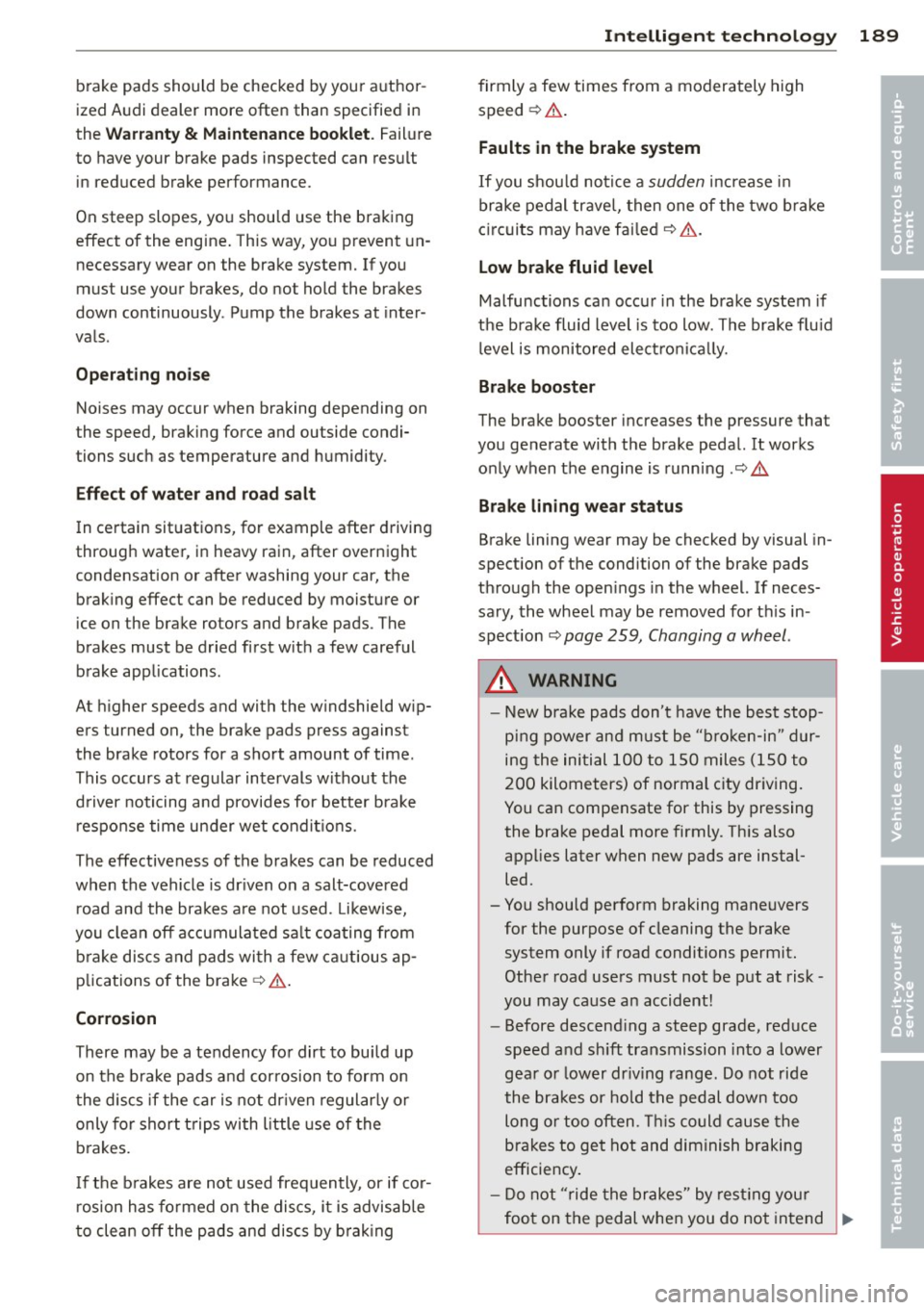
brake pads should be checked by your a uthor
ized Audi dealer more often than specified in
the
War ranty & M aint enance booklet . Failure
to have your brake pads inspected can res ult
in reduced brake performance.
On steep slopes, you shou ld use the braking
effect of the engine . This way, you prevent un
necessary wear on the brake system. If you
must use your brakes, do not hold the brakes
down continuously . Pump the brakes at inter
vals.
Operating no ise
Noises may occur when braking depending on
the speed, braking force and outside condi
tions such as temperature and humidity.
Effect of w ater and ro ad salt
In certain sit uations, for example after driving
through water, in heavy rain, after overnight
condensation or after washing your car, the brak ing effect can be reduced by moisture or
ice on the brake rotors and brake pads. The
brakes must be dried first with a few careful
brake app lications.
At h igher speeds and with the w indshield w ip
ers turned on, the brake pads press against
the brake rotors for a short amount of time.
This occurs at regula r intervals without the
d river noticing and provides for better brake
response time under wet condit ions.
The effectiveness of the brakes can be reduced
when the vehicle is dr iven on a salt-covered
road and the brakes a re not used . L ikew ise,
you clean off a ccumulated sa lt coating from
brake discs and pads with a few ca utious ap
p lications of the brake
c:> .&. .
Cor rosion
There may be a tendency for dirt to bu ild up
on the brake pads a nd corrosion to form on
the discs if the car is not dr iven regular ly or
only for short t rips with little use of the
b rakes.
I f the b rakes are not used frequently, or if cor
r osion has formed on the discs, it is advisab le
t o clean off the pads and discs by brak ing
Int ellig ent technolog y 189
firmly a few times from a moderately h igh
speed
c:> .&. .
Faults in the brake s yst em
If you shou ld notice a sudden in crease in
brake pedal trave l, then one of the two brake
c ircuits may have fai led
c:> .&. .
Lo w brake fluid l ev el
Malfunctions can occur in the brake system if
the brake fluid level is too low . The brake flu id
level is monitored elect ro nica lly.
Brake booster
The brake booster increases the pressure that
you generate with the brake peda l. It works
only when the engine is running
.c:> .&
Brake lining wear statu s
Brake lining wear may be checked by visual in
spection of the condition of the brake pads
through the open ings in the wheel. If neces
sa ry, the wheel may be removed for th is in
spect ion
c:> page 259, Changing a wheel.
A WARNING
- New brake pads don' t have the best stop
ping power and m ust be "bro ken-in" dur
ing the initial
100 to 150 miles (150 to
200 kilometers) of normal c ity driving.
You can compensate for this by pressing the brake pedal more firmly. Th is also
applies later when new pads are instal
led.
- You should perform braking maneuvers for the purpose of cleaning the brake
system only if road conditions permit.
Other road use rs must not be put at risk -
you may ca use an accident!
- Before descend ing a steep grade, reduce
speed and sh ift transmission into a lower
gea r or l ower dr iving range . Do not ride
the brakes or hold t he pedal down too
long or too often . Th is could cause the
brakes to get hot and diminish braking
efficiency .
- Do not " ride the brakes" by res ting you r
foo t on the pedal when you do not intend .,..
•
•
Page 192 of 302
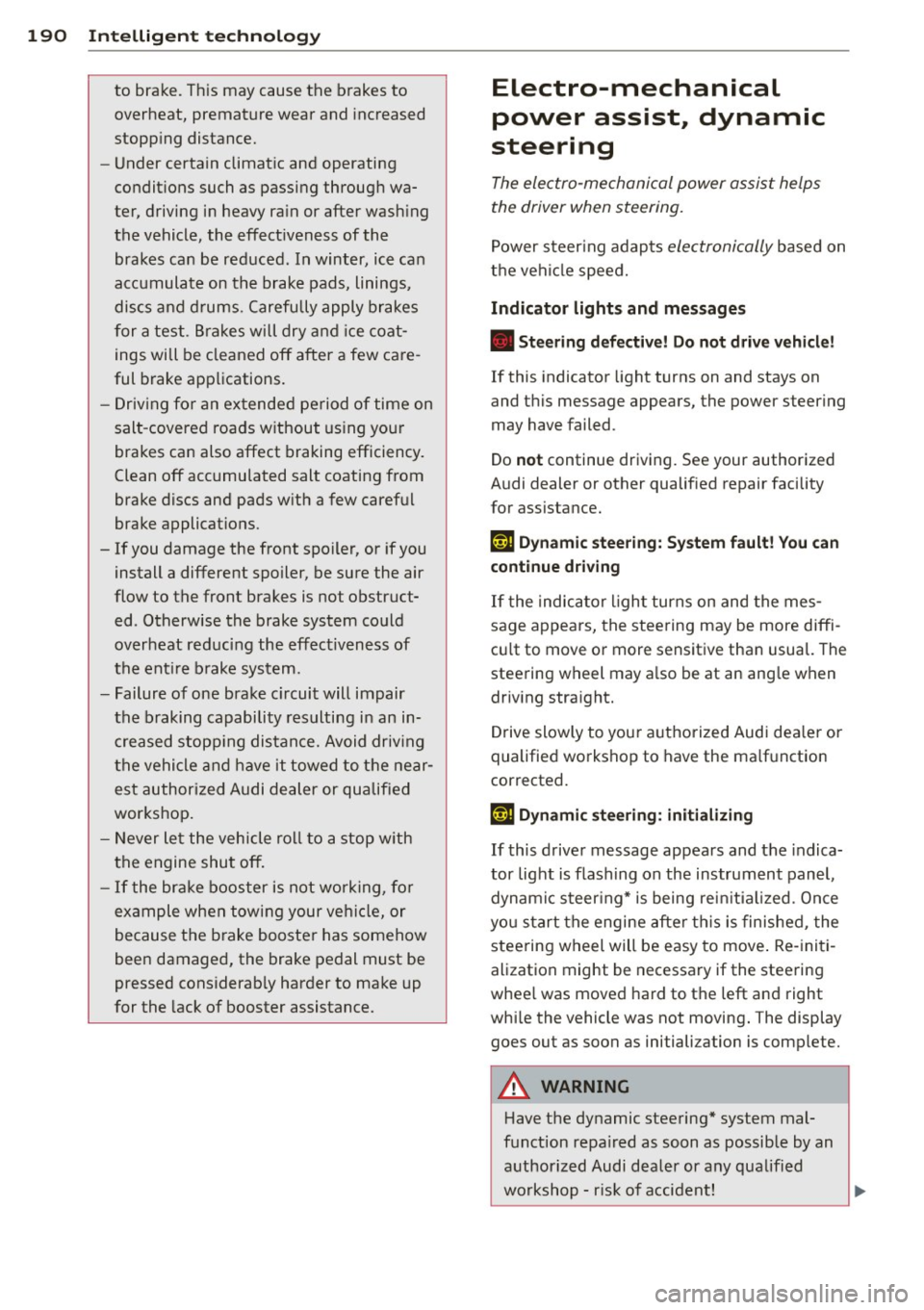
190 Intelligent technology
to brake. This may cause the brakes to
overheat, premature wear and increased
stopp ing distance.
- Under certain climatic and operating
condit ions such as passing through wa
ter, driving in heavy ra in or after wash ing
the vehicle, the effect iveness of the
brakes can be reduced . In winter, ice can
accumulate on the brake pads, linings,
discs and drums. Carefully apply brakes
f or a test . B rakes will dry a nd ice coat
ings will be cleaned off after a few ca re
ful brake applications.
- Driv ing for an extended pe riod of time on
salt -covered roads without using you r
brakes can also affect braking efficiency.
Clean off accumulated salt coating from
brake discs and pads w ith a few careful
brake applicat ions.
- If you damage the front spoiler, or if you
install a different spoiler, be sure the air
flow to the front brakes is not obstruct
ed . O therwise the brake system could
overheat reducing the effectiveness of
the ent ire brake system.
- Failure of one brake c ircuit will impair
the braking capability resulting in an in creased stopp ing distance. Avoid driv ing
the vehicle and have it towed to t he near
est author ized Audi dealer or qualif ied
workshop.
- Never let the vehicle roll to a stop w ith
the engine shut off.
- If the brake booster is not working, for
example when towing your ve hicle, or
because the b rake booste r has somehow
been damaged, the brake pedal must be
pressed considerab ly harder to make up
for the lack of booster assistance.
Electro-mechanical
power assist, dynamic
steering
The electro-mechanical power assist helps
the driver when steering.
Power steer ing adapts electronically based on
the veh icle speed.
Indicator lights and messages
• Ste ering d efe ct ive ! Do not d rive vehicle!
If this indicator light turns on and stays on
a nd this message appears, the power steering
may have failed .
Do
not continue driving. See your authorized
Audi dealer or other qualified repair facility
for assistance.
'Tij D ynamic steer ing: Sy stem f au lt! You c an
cont inue d riving
If the indicator l ight turns on and the mes
sage appears, the stee ring may be more diffi
c ul t to move o r more sensitive than usua l. The
steering wheel may a lso be at an ang le when
driv ing straight.
Drive slowly to your authorized Audi dea ler or
qualified workshop to have the ma lf u nction
corrected.
'Tij Dynamic stee rin g: initializing
If this driver message appears and the indica
tor light is flashing on the instrument panel, dynamic steer ing* is being re initia lized . On ce
you start the engine after t his is finished, the
steering wheel will be easy to move . Re-initi
alizat ion might be necessary if the steering
whee l was moved hard to the left and right
whi le the vehicle was not moving. The display
goes out as soon as initiali zation is complete.
A WARNING
-Have the dynamic steering* system mal
function repa ired as soon as possible by an
authorized Audi dealer or any qualified
workshop - r is k of accident!
-
Page 193 of 302
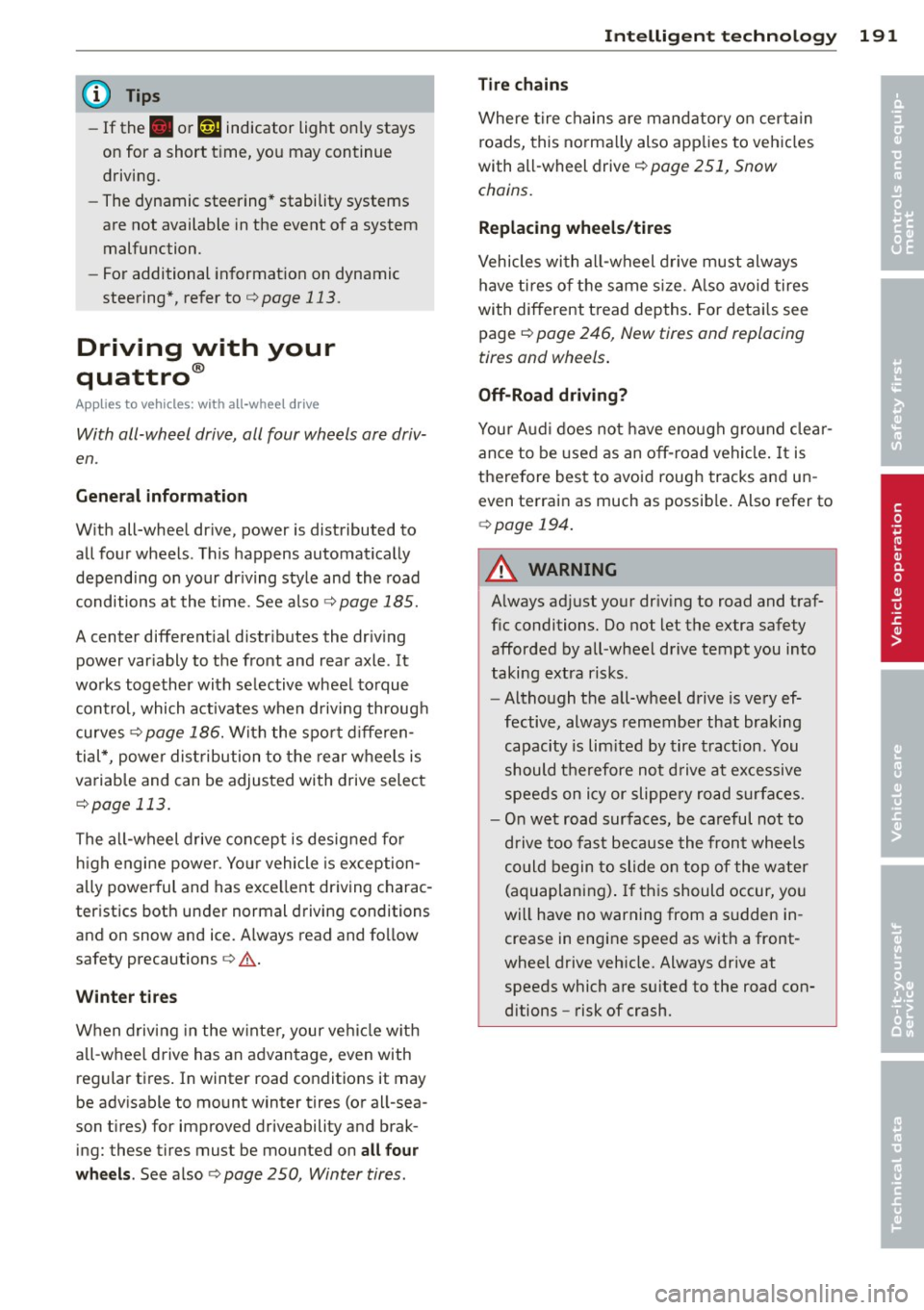
@ Tips
- If the . or
fT j indicator light on ly stays
on for a short t ime, you may continue
driving.
- The dynamic steering* stability systems
are not available in the event of a system
malfunction.
- For additional information on dynamic
steering*, refer to
c:> page 113.
Driving with your
quattro ®
Applies to vehicles: with a ll-wheel drive
With all-wheel drive, all four wheels are driv
en.
Gener al inform ati on
W ith all-wheel drive, power is distributed to
all four wheels . This happens automatically
depending on your dr iving style and the road
conditions at the t ime. See also
c:> page 185.
A center different ial distr ibutes the dr iv ing
power var iably to the front and rear axle . It
works together with selective wheel torque
control, which activates when driving throug h
curves
c:> page 186. With the spo rt d ifferen
tial*, power dist ribution to the rear wheels is
variable and can be adjusted with drive select
c:> page 113.
The all-wheel drive concept is designed for
h igh engine power. Yo ur vehicle is exception
ally powerful and has exce llent driving charac
teristics both under normal driving conditions
and on snow and ice. Always read and fo llow
safety precautions
c:> A .
Winter t ir e s
When driv ing in the w inter, your veh icle w ith
all-wheel drive has an advantage,
even with
regular tires. In winter road conditions it may
be advisable to mount winter tires (or all-sea
son t ires) for improved driveability and brak
ing: these tires must be mounted on
a ll four
w heels . See also c:> page 250, Winter tires .
Intellig ent technolog y 191
Tire chain s
Where tire chains are mandatory on certain roads, this no rma lly also applies to veh icles
with all-wheel drive
c:> page 251, Snow
chains.
Replacing wheels /tires
Vehicles with a ll-wheel drive must always
have tires of t he same s ize. A lso avoid tires
with different tread depths . For detai ls see
page
c:> page 246, New tires and replacing
tires and wheels .
Off-Road driving?
You r A udi does no t have enough ground clear
ance to be used as an off-road vehicle .
It is
therefore best to avoid rough tracks and un
even terrain as much as possib le . Also refer to
c:> page 194.
A WARNING
Always adjust your dr iving to road and traf
f ic conditions. Do not let the extra safety
afforded by all-wheel drive tempt you into
taking extra risks .
- Although the all-wheel drive is very ef
fective, always remember that braking
capacity is lim ited by tire traction. You
should therefore not d rive at excessive
speeds on icy or slippe ry road surfa ces.
- On wet road surfaces, be careful not to
drive too fast because the front wheels
co uld begin to slide on top of the water
(aquaplaning) . If this should occur, yo u
will have no warning from a s udden in
crease in engine speed as w ith a front
wheel drive veh icle. Always drive at
speeds which are su ited to the road con
ditions -risk of crash.
•
•
Page 194 of 302

192 Intelligent technology
Energy management
Starting ability is optimized
Energy management controls the distribution
of electrical energy and thus optimizes the
availability of electrical energy for starting
the engine.
If a vehicle with a conventional energy system
is not driven for a long period of time, the bat
tery is d ischarged by idling current consumers
(e.g. immobilizer). In ce rtain circumstances it
can result i n there bei ng insuff ic ient ene rgy
avai lab le to start the engine .
Intell igent energy management in your vehi
cle hand les the d ist ribu tion of elect rical ener
gy. Starting ab ility is mar ked ly imp roved and
the life of the battery is extended .
Basically , energy management consists of
batt ery diagno sis , idling curr ent manag e
ment
a nd dynami c energy man agement .
Battery diagnosis
Battery d iagnosis continuously determ ines
the state of the battery . Sensors determ ine
battery vo ltage, battery current and battery
temperature . This dete rm ines the current
sta te of charge and the power of the ba ttery.
Idling current management
Idling current management reduces energy
consumption wh ile the vehicle is stand ing .
W ith the ignition switched off, it cont ro ls the
ene rgy s upply to the va rio us e lectrica l compo
nents . Data from battery diagnosis is consid
e red.
Depending on the battery's state of charge,
i nd ividua l consumers are grad ually t urned off
to p revent ex cess ive d isc harge of the ba ttery
and thus mainta in start ing capability.
Dynamic energy management
While the vehicle is be ing dr iven , dynamic en
e rgy management dist ributes t he energy gen
e rated accordi ng to the needs of the individu
a l componen ts.
It reg ulates consump tion, so
that more electrical ene rgy is not being used than
is being generated and ensures an opti
mal state of charge for the battery.
(D Tips
- But even energy man ageme nt canno t
negate the limi ts of physics . Conside r
that the powe r and life of a battery are
limited .
- If start ing ability is threatened, the indi
cator light (•) appears ~
page 17.
What you should know
The highest priority is given to maintaining
starting capability .
The b attery is severe ly taxed in short -d istance
driv ing, in ci ty traff ic and during t he cold time
of yea r. Ab undant electrical energy is re
quired, but on ly a little is generated . It is also
critical if the engine is not r unning and electri
ca l components are turned on . In this in
stance ene rgy is be ing consumed but none is
being generated .
It is in precisely these s ituations that you will
notice energy management active ly reg ulat
ing the d istribution of energy.
Vehicle stand s for an e xtended period
If you do not drive your vehicle over a period
of several days or weeks, e lectrica l compo
nents are gradually cut back or sw itched off.
This reduces energy consumption and ma in
ta ins start ing capability over a longer pe riod .
Some of the convenience functions may not
operate, such as the interior lights or the
power seat adjustme nt. The convenience
f unc tions wi ll be available again when yo u
swi tch on the igni tion and sta rt the eng ine .
With the engine turned off
If you listen to the radio, for examp le, w it h
the engine t urned off or use other MMI func
t ions, t he battery is be ing discharged.
If starting capability is jeopardized due to en
ergy consump tion, the following warning ap-
pears in the MM I display: .,,.
Page 195 of 302
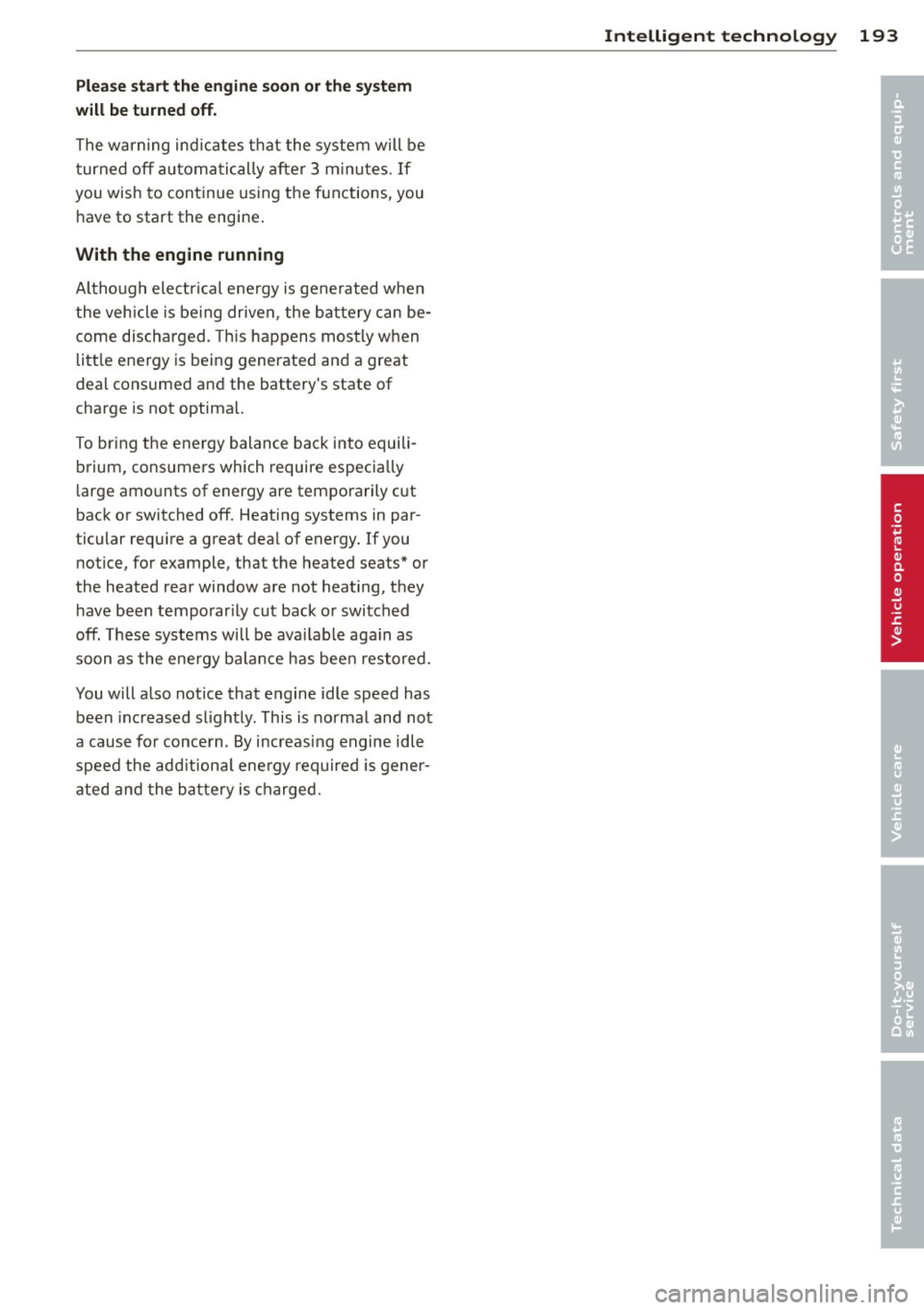
Please start the engine soon or the system
will be turned off.
The warning ind icates that the system will be
turned off automa tically after 3 minutes. If
you wish to continue using the functions, you
have to start the engine .
With the engine running
Although electrical energy is generated when
the vehicle is be ing driven , the battery can be
come discharged. This happens most ly when
litt le energy is being generated and a great
deal consumed and the battery's state of
charge is not optimal.
To br ing t he ene rgy balance back into equili
brium, consumers which require especially
l arge amounts of energy are temporarily cut
back or switched off. Heating systems in par
ticular requ ire a great deal of energy. If you
notice, for example, that the heated seats* or
the heated rear window are not heating, they
have been temporar ily cut back or switched
off. These systems will be ava ilable again as
soon as the energy ba lance has bee n restored.
You will also notice that engine idle speed has
been increased slightly . This is normal and not
a cause for concern. By increasing engine idle
speed the add itional ene rgy required is gener
ated and the ba ttery is charged.
Intelligent technology 193
•
•
Page 196 of 302
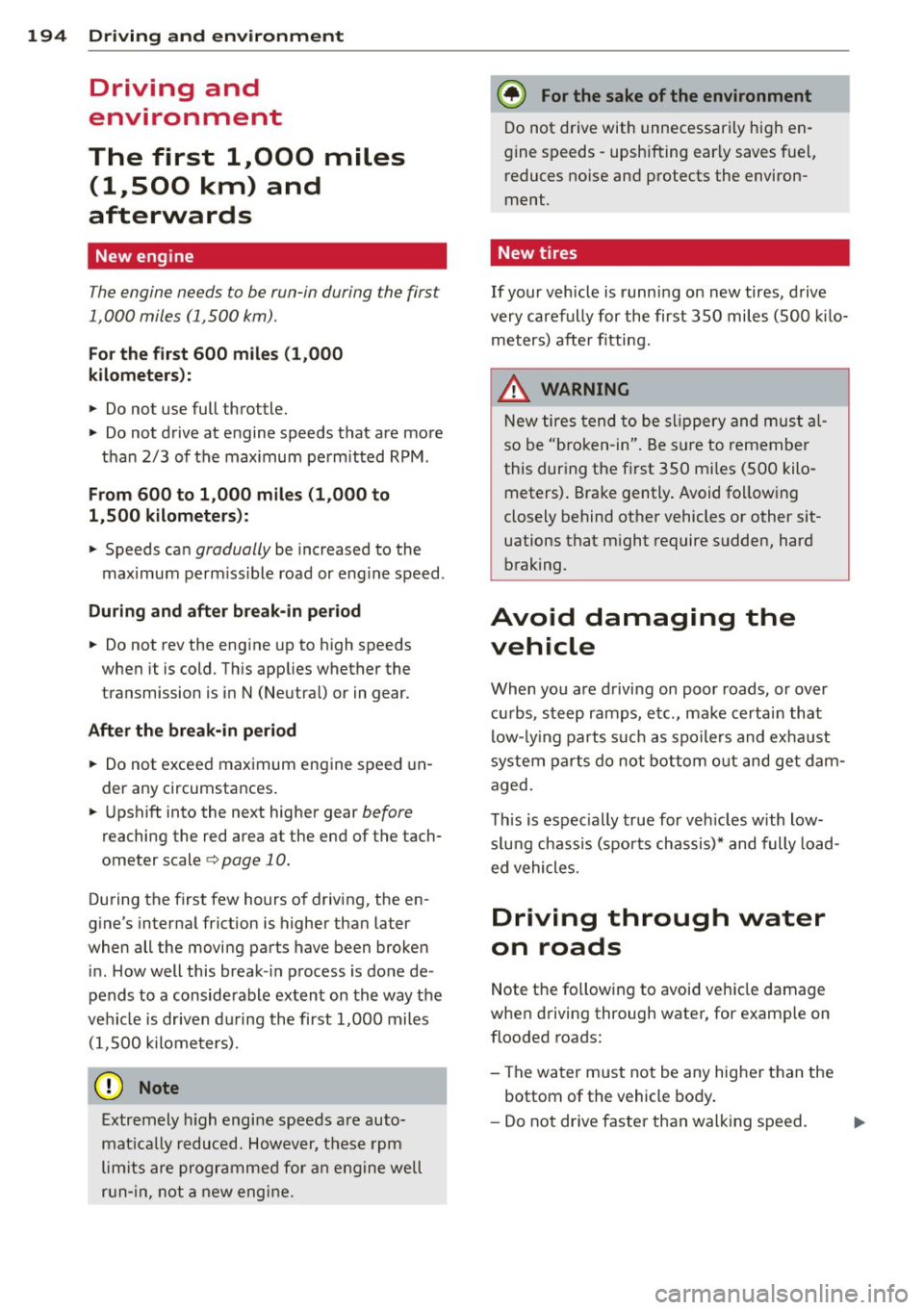
194 Driving and environment
Driving and
environment
The first 1,000 miles
(1,500 km) and
afterwards
New engine
The engine needs to be run-in during the first
1,000 miles (1,500 km).
For the fir st 600 miles (1,000
kilometers ):
.,. Do not use full throttle.
... Do not drive at engine speeds that are more
than 2/3 of the max imum permitted RPM.
From 600 to 1,000 miles (1 ,000 to
1,500 kilometers):
.,. Speeds can gradually be increased to the
max imum pe rm iss ible road or eng ine speed .
During and after break-in per iod
... Do not rev the eng ine up to h igh speeds
when it is cold. Th is app lies whether the
transmission is in N (Neutral) or in gear.
After the break- in period
... Do not exceed max imum eng ine speed un
der any circumstances .
... Upshift into the next higher gear
before
reaching the red area at the end of the tach
ometer scale¢
page 10.
During the first few hours of driving, the en
g ine's inter na l friction is higher tha n later
when alt the moving parts have been broken
i n. How welt this break- in process is done de
pends to a conside rable extent on the way the
ve hicl e is driven du ring the first 1,000 miles
(1, 500 kilome ters).
(D Note
E xtremely high engi ne speeds are auto
mat ica lly re duced. However, these rpm
lim its are programmed for a n engine welt
r u n- in, not a new eng ine.
{® For the sake of the environment
Do not drive with unnecessarily high en
g ine speeds - upshifting ear ly saves fuel,
reduces no ise and protects the environ
ment.
, New tires
If your vehicle is runni ng on new tires, drive
very carefully for the first 350 miles (500 kilo meters) after fitting.
_& WARNING
N ew tires tend to be slip pery a nd mus t al
so be "broken -in" . Be s ure to remembe r
this dur ing the fi rst 350 mi les (500 kilo
meters) . Brake gently . Avoid fo llow ing
closely behind other vehicles or other sit
uations that m ight require sudden, hard
braking.
Avoid damaging the
vehicle
When you a re d rivi ng on poo r roads, or over
cu rbs, ste ep ramps, etc., ma ke certai n that
low- ly ing parts s uch as spoile rs and ex ha ust
s ystem parts do not bot tom o ut and get dam
aged.
T his is espec ially true for veh icles with low
s lu ng chassis (s por ts chassis)* and fully load
ed vehicles.
Driving through water
on roads
Note th e following to avoid vehicle damage
whe n driving through water, for examp le on
flooded roads:
- The wa ter must not be any hig he r th an the
bottom of the vehicle body .
- Do not dr ive faste r than walk ing speed.
Page 197 of 302
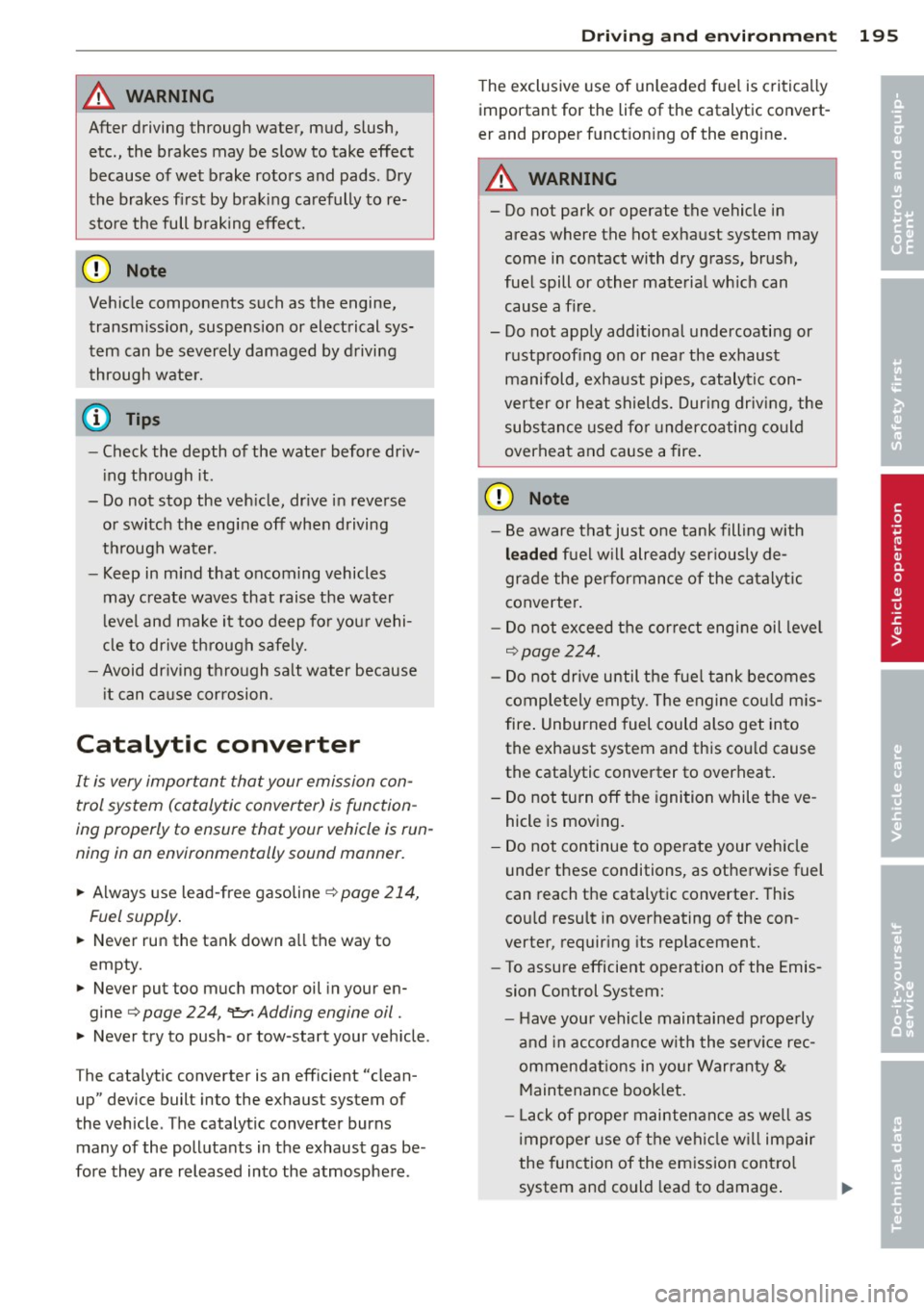
A WARNING ,~ ~
After driving through water, mud, slush,
etc., the brakes may be slow to take effect
because of wet brake rotors and pads. Dry
the brakes first by braking carefully to re
store the full brak ing effect.
([) Note
Vehicle components such as the engine,
transmiss ion, suspension or electrical sys
tem can be severely damaged by driving
through wate r.
@ Tips
- Check the depth of the water before dr iv
i ng through it.
- Do not stop the veh icle, dr ive in reverse
or switch the engine off when driving
th rough water.
- Keep in mind that oncoming vehicles
may create waves that raise the water
level and make it too deep for you r vehi
cle to drive th rough safely.
- Avoid dr iving through sa lt water because
i t can ca use corrosion.
Catalytic converter
It is very important that your emission con
trol system (catalytic converter) is function
ing properly to ensure that your vehicle is run
ning in an environmentally sound manner.
11-Always use lead-free gasoline q page 214,
Fuel supply .
"'" Never run the tank down a ll the way to
empty.
11-Never put too much motor oil in your en-
gine
q page 224, ~ Adding engine oil .
11-Never try to push -or tow-start your veh icle .
The catalytic converter is an efficient "clean up" device built into the exhaust system of
the vehicle . The catalytic converter burns
many of the pollutants in the exhaust gas be
fore they are released into the atmosphere .
Drivin g and en vironm ent 195
The exclusive use of unleaded fuel is critically
important for the life of the catalytic convert
er and proper funct ion ing of the engine.
A WARNING
-
- Do not park or operate the vehicle in
areas where the hot exhaust system may
come in contact with dry grass, brush,
fuel spill or other mate rial wh ich can
cause a fir e.
- Do not apply additional undercoating or rustp roof ing on or near the exhaust
manifold, exhaust pipes, catalytic con
ve rter or heat shields. During driv ing, the
substance used for undercoating co uld
overheat and cause a fire.
(D Note
- Be aware that just one tank filling with
leaded fu el w il l already ser iously de
gra de the performance of the catalytic
c onverte r.
- Do not ex ceed t he cor rect eng ine oil level
qpage 224.
- Do not drive until the fue l tank becomes
comple tely empty. The engine co uld m is
fire . Unburned fuel could also get in to
the exhaust system and th is co uld cause
the catalytic converter to overheat .
- Do not turn off the ignition while the ve
hicle is moving.
- Do not continue to ope rate your veh icle
unde r these conditions, as otherwise fuel
can reach the catalytic converte r. T his
cou ld result in overheating of the con
verter, requir ing its replacement.
- To assure efficient operation of the Emis
sion Control System:
- H ave you r vehicle maintained prope rly
and in accorda nce w ith the serv ice rec
ommendat ions in yo ur Warranty &
M ain tenance boo klet.
- L ack of prope r maintenance as we ll as
improper use of the vehi cle w ill impair
the function of the em ission contro l
system and could lead to damage . ..,. •
•
Page 198 of 302
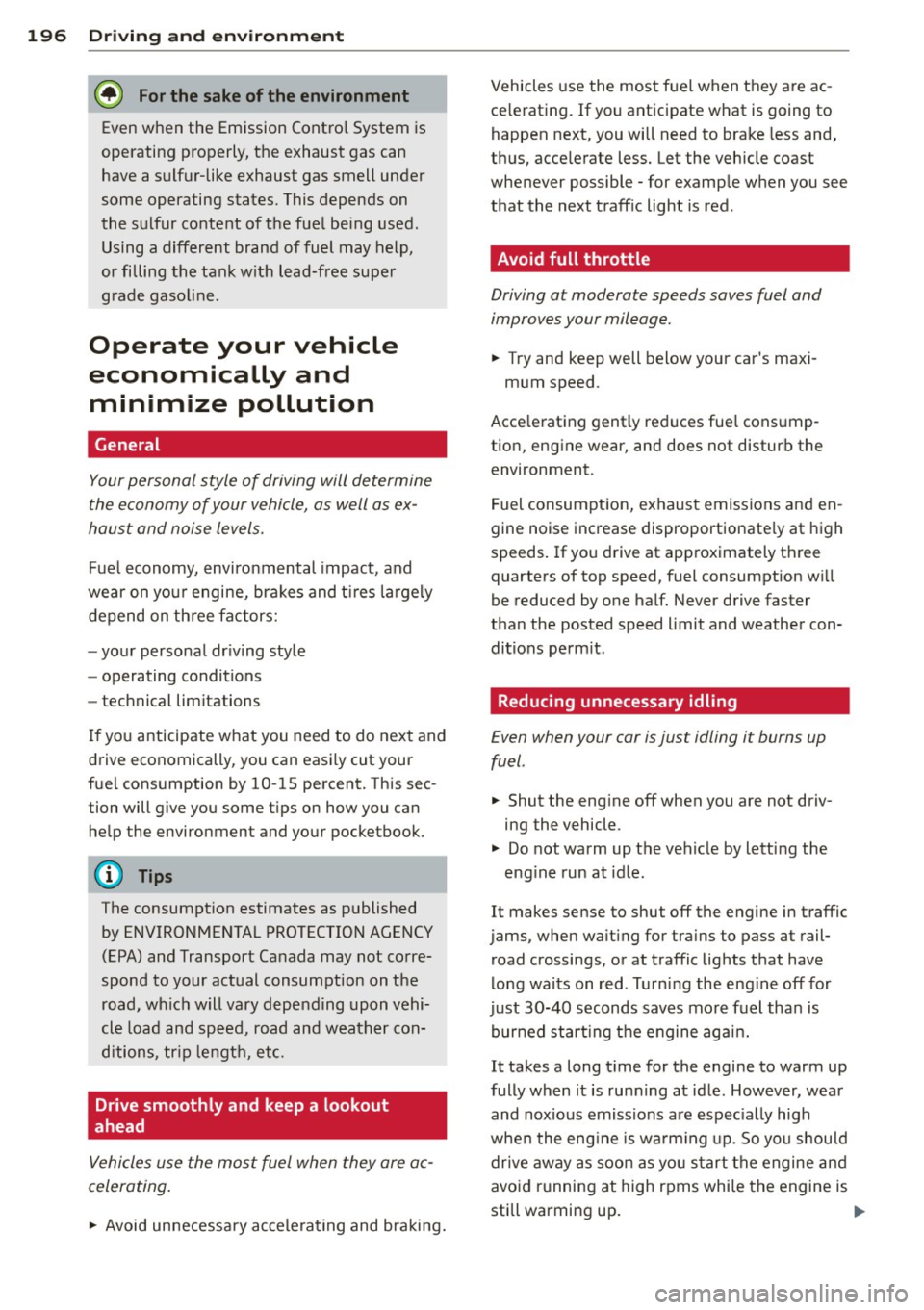
196 Driving and en vironm ent
@ For the sa ke of the environment
Even when the Emission Contro l System is
operating properly, the exhaust gas can
have a sulfur-like exhaust gas smell under
some operating states. This depends on
the sulfur content of the fue l being used .
Using a different brand of fuel may help,
or filling the tank w ith lead-free super
grade gasoline.
Operate your vehicle
economically and minimize pollution
General
Your personal style of driving will determine
t he economy of your vehicle, as well as ex
haust and noise levels.
Fue l economy, environmental impact , and
wear on you r engine, bra kes and t ires la rgely
depend on th ree factors:
= yo ur personal dr iv ing sty le
- operating conditions
- technical lim itations
If yo u anticipate what you need to do next and
drive economically, you can easi ly cut your
fue l consumption by 10-15 percent. This sec
tion will give you some t ips on how you ca n
he lp the environmen t and your pocketbook.
(D Tips
The consumpt ion estimates as published
by ENVIRONMENTAL PROTECTION AGENCY
(EPA) and Transport Canada may not co rre
spond to your actual consumption on the
road, wh ich will vary depending upon vehi
cle load an d speed, road and weather con
ditions, tr ip le ngth, etc.
Drive smoothly and keep a lookout
ahead
Vehicles use the most fuel when they are ac
celerating .
.,. Avoid unnecessa ry accelerating and braking. Vehicles use the most fuel when they are ac
ce le rating. If you anticipate what is going to
happen next, you will need to brake less and,
th us, acce lerate less. Let the vehicle coast
whenever possible -for example when you see
that the next traff ic light is red .
· Avoid full throttle
Driving at moderate speeds saves fuel and
improves your mileage.
.. Try and keep well below your car's maxi-
m um speed .
Acce lerat ing gently red uces fue l cons ump
tion, engine wear, and does not disturb the
environment.
F uel consumpt ion, exhaust emissions a nd en
gine noise inc rease disproportionate ly at high
speeds . If yo u drive at approximately th ree
quarters of top speed, fuel consumption w ill
be reduced by one half. Never drive faster
than the posted speed limit and weathe r con
ditions pe rm it.
Reducing unnecessary idling
Even when your car is jus t idling it burns up
fuel.
.. Shut the eng ine off when you are not driv
ing the vehicle .
.. Do not warm up the vehicle by letti ng the
eng ine run at idle .
It makes sense to shut off the engine in traffic
jams, when wa it ing for tra ins to pass at rail
r oad crossings, or at traffic lig hts that have
long wai ts on red . Tu rn ing the eng ine off for
j ust 30-40 seconds saves more fuel tha n is
burned start ing t he e ngine aga in.
It takes a long t ime for the engine to warm up
fully when it is ru nning at id le. However, wea r
and noxious emissions a re espec ia lly high
whe n the eng ine is wa rm ing up. So you s hou ld
dr ive away as soon as yo u start the engine and
avo id running at high rpms whi le the engine is
still warming up.
ll-
Page 199 of 302
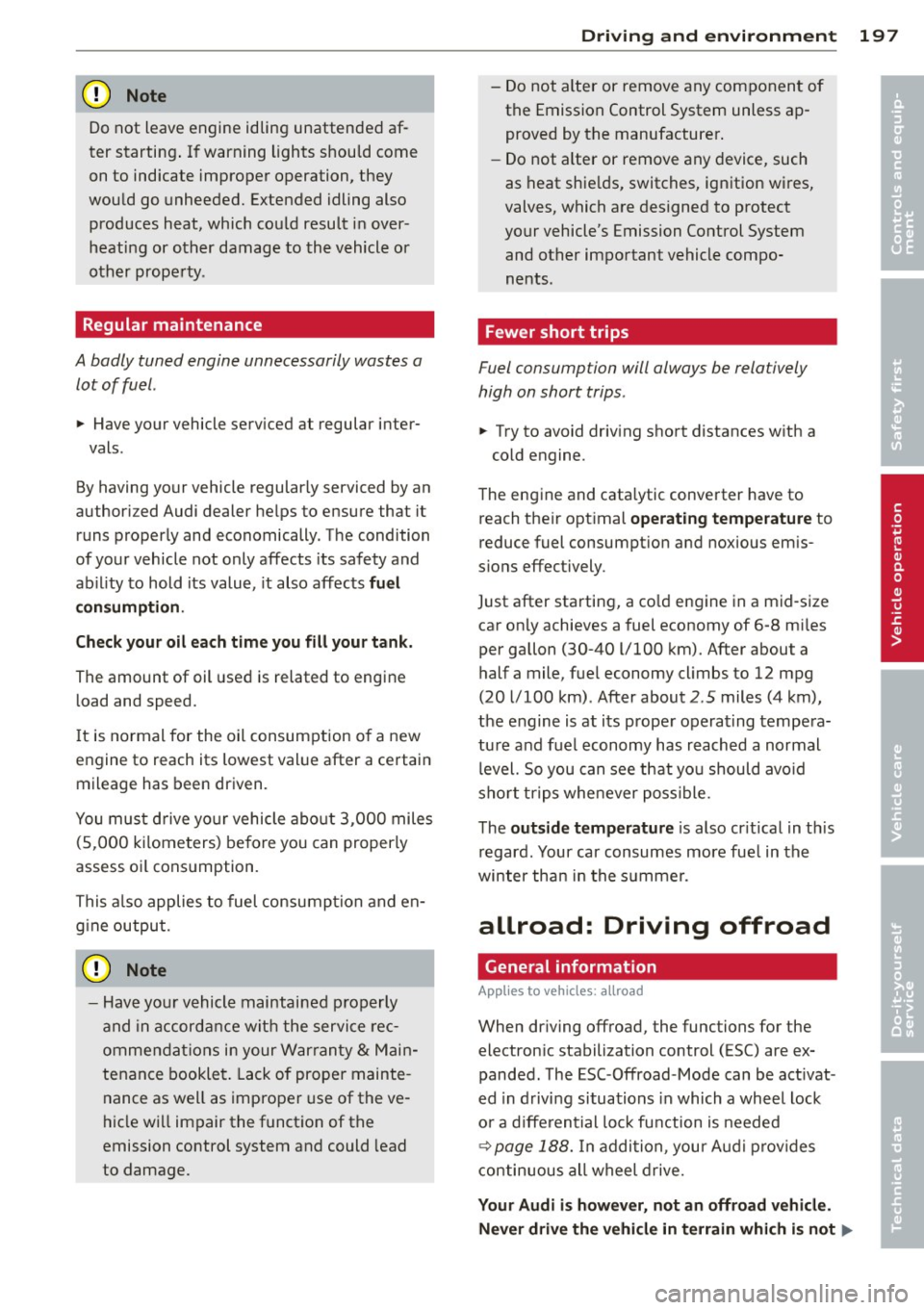
(D Note
Do not leave engine idling unattended af
ter starting . If warning lights should come
on to indicate improper operation, they
would go unheeded. Extended idling also
produces heat, which could result in over
heating or other damage to the vehicle or
other property .
Regular maintenance
A badly tuned engine unnecessarily wastes a
lot of fuel .
.,. Have your vehicle serv iced at regular inter-
vals .
By having your vehicle regularly serviced by an
author iz ed Audi dealer helps to ensure that it
runs properly and economically . The condition
of your vehicle not only affects its safety and
ab il ity to hold its value, it also affects
fu el
c onsump tion .
C hec k your oil each tim e you fill your t ank .
The amount of oil used is related to engine
load and speed.
It is normal for the oil consumption of a new
engine to reach its lowest value after a certain
mileage has been driven.
You must d rive yo ur vehicle about 3 ,000 miles
(5,000 kilometers) be fore you can properly
assess oi l consumption.
This a lso applies to fuel consumption and en
g ine output .
0 Note
-Have your vehicle maintained properly
and in accordance wit h the service rec
ommendat ions i n your Warranty
& Main
tenance booklet . Lack of proper mainte
nance as well as improper use of the ve
hicle wi ll impair the function of the
emission control system and could lead
to damage.
Dri vin g and en vironm ent 197
-Do not alter or remove any component of
the Emission Control System unless ap
proved by the manufacturer .
- Do not alter or remove any device, such
as heat shie lds, switches, ignition wires,
valves, which are designed to protect
your vehicle's Emission Control System and other important vehicle compo
nents .
Fewer short trips
Fuel consumption will always be rela tively
high on short trips .
.,. Try to avoid driving short distances with a
cold engine.
The engine and cata lytic converter have to
reach their opt imal
op erati ng t emper ature to
reduce fuel consumpt ion and noxious emis
s ions effectively .
Just after starting, a co ld engine in a mid-size
car only achieves a fuel economy of 6-8 mi les
per gallon (30-40 l/100 km). After about a
half a mile, fuel economy climbs to 12 mpg
(20 l/100 km) . After about
2 .5 miles (4 km),
the e ngine is at its proper operat ing tempera
ture and fue l economy has reached a normal
level. So you can see that you should avo id
short trips whenever poss ible.
T he
outs ide t emp erature is also cr itical in th is
regard. Your car consumes more fue l in the
winter than in the summer.
allroad : Driving offroad
General information
App lies to vehicles : allroad
When d riving offroad, the functions for the
electron ic stabilization control (ESC) are ex
panded. The ESC -Offroad -Mode can be act ivat
ed in driving situations in which a whee l lock
o r a d iffe rential lock function is needed
~ page 188. In addition , you r Audi p rov ides
continuous all wheel drive.
Your Audi i s ho wever, no t an offroad vehicl e.
Nev er drive the vehicle in terrain which i s not
lilJJ,,
•
•
Page 200 of 302
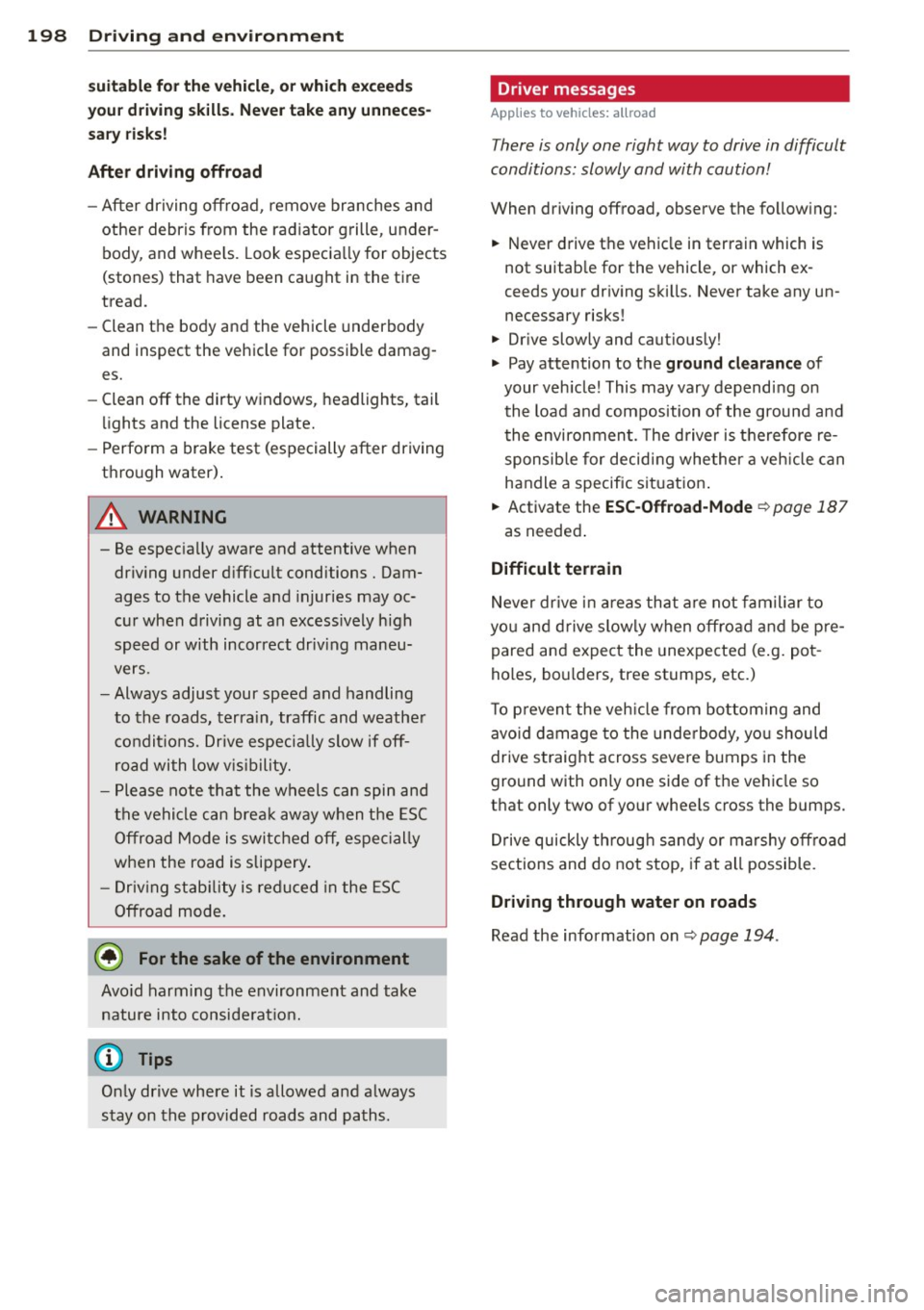
198 Driving and en vironm ent
s uit able for the vehicl e, or w hic h ex ceed s
y ou r dr iving sk ill s. N eve r tak e an y unnec es
s a ry risks!
After driv ing offro ad
- After driving offroad, remove branches and
other debris from the rad iator grille, under
body, and whee ls. Look especia lly for objects
(stones) that have been caught in the tire
tread .
- Clean t he body and the vehicle underbody
and inspect the vehicle for possible damag
es.
- Clean off the dirty windows, headlights, tail
lights and the license plate.
- Perform a brake test (especially after driving
through water) .
A WARNING
- Be especially aware and attentive when
dr iv ing under d iff icult conditions. Dam
ages to the vehicle and injuries may oc
cur when driving at an excess ively high
speed or with incorrect driv ing maneu
vers.
- Always adjust your speed and handling
to the roads, terra in, traffic and weather
condit ions. Drive especially slow if off
road with low v is ibility.
- Please note that the wheels can spin and
the vehicle can brea k away when the ESC
Offroad Mode is switched off, espec ially
whentheroadisslipper~
- Driv ing stab ility is red uced in the ESC
Offroad mode.
@) For the sake of the environment
Avo id harming the environment and take
nature into conside rat ion.
@ Tips
Only drive where it is allowed and always
stay on the provided roads and paths.
Driver messages
App lies to veh icles : all road
There is only one right way to drive in difficult
conditions: slowly and with caution!
When driving offroad, observe the follow ing :
.. Never drive the vehicle in terrain which is
not suitab le for the vehicle, or which ex
ceeds your driving ski lls. Never take any un
necessary risks!
.. Drive slowly and caut iously!
.. Pay attention to the
ground clearanc e of
your veh icle! This may vary depending on
the load and composition of the ground and
t he environment. The d river is therefore re
sponsib le for deciding whether a veh icle can
handle a specific situation .
.. Activate the
ESC-Offroad-Mode r::;, page 187
as needed .
Difficult terrain
Never drive in areas that are not fam iliar to
you and d rive slowly when offroad and be p re
pared and expect the unexpected (e .g. pot
holes, boulders , tree stumps, etc.)
T o p reven t the veh icle from bottoming and
avo id damage to the unde rbody, yo u should
drive straight across severe bumps in the
ground with only one side of the ve hicle so
that only two of your whee ls cross the bumps.
Drive quickly th rough sandy or marshy offroad
sections and do not stop, if at all possible.
Driving through water on roads
Read the information on r::::> page 194 .